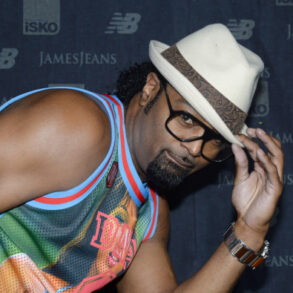PARIS — Since November, the French hip-hop world has been in turmoil. A true French art form is currently under siege, and defending the future of the genre means remembering its past — and its roots in France.
A highly contested, newly proposed law meant to “professionalize dance education” is seen as trying to kill the genre. According to that law, hip-hop dance teachers would be required to hold a state diploma to teach. But in response, many members of France’s hip-hop community have signed a petition against the institutionalization of dance and for the promotion of popular culture.
Without question, hip-hop is core to French culture. For decades, France has been the second-largest market for hip-hop in the world after the United States. According to American historian Samir Meghelli, “France has one of the longest cultural histories of hip-hop.”
In 1984, Sidney Duteil, who is known as Sidney and was the first Black presenter on French TV, hosted “H.I.P.H.O.P.,” a legendary show that was among the first mainstream TV slots in the world dedicated to hip-hop. That show aired on TF1, one of the biggest channels in Europe, at a time when hip-hop was still invisible in much of American mainstream media.
Hip-hop emerged in France when the children of immigrants from former colonies began to be visible in the public sphere, voicing their concerns against racism and relegation. The famous December 1983 March for Equality and Against Racism through Paris drew 100,000 people with genuine enthusiasm, and the moment when many young people were introduced to the new art form that had originated in the Bronx.
Since then, Paris has been home to the most prolific artists — dancers, graffiti artists and rappers — inspired by hip-hop, and many of its neighborhoods are marked by the history of a movement that is still visible in its streets. Quite simply, the City of Lights is one of the world’s major hip-hop capitals.
Le Bataclan
The name “Bataclan” tragically became synonymous with the horrendous terrorist attacks of November 2015, but few remember how central the concert hall has been to hip-hop culture in France. The self-professed “birthplace of Hip-Hop in France,” the Bataclan hosted the first U.S. hip-hop tour in France in 1982, including Afrika Bambaataa.
Thanks to DJ Chabin, the Bataclan was also a place for dance practice in which future rap stars including Joey Starr and Kool Shen took part, when much of the media was all too quick to dismiss hip-hop dance as “smurf.”
Salle Paco Rabanne
Unexpectedly, the revered Spanish fashion designer Paco Rabanne had a pivotal role in the spreading of hip-hop culture in France.
Rabanne purchased a loft in a low-income neighborhood in the northeast of Paris, which was initially meant to be a rehearsal room for his fashion shows. But he soon opened it to African dancers and singers and, finally, hip-hop dancers, who in turn made the place famous.
Familiar with hip-hop thanks to his numerous visits to New York City, Rabanne, then in his fifties, became one of the major philanthropists to support the budding genre.
Vacant lot La Chapelle / Stalingrad
Quoted in NTM’s song “Tout n’est pas si facile,” or “All Is Not So Easy,” Stalingrad — an area in northeastern Paris — was the perfect spot for graffiti given that it lies underneath an elevated metro bridge. The view from the train cars above was incomparable: iconic street artists, including the legendary Ash from the BBC (Bad Boys Crew), created the most elaborate murals there.
When minors were restricted from Rabanne’s venue, a few dozen meters away, in 1985, young people had to find a new place to congregate and make art. La Chapelle became the perfect place to dance and to rap. In 1986, pioneering rapper Dee Nasty created underground “free jams” — inspired by New York’s famous “block parties” — that brought together young people, many coming from the Paris suburbs. Unfortunately, local police cracked down on this initiative, and those “free jams” are no more.
Les Halles
Situated in the heart of Paris, Les Halles is no longer the working-class neighborhood it used to be.
In the 1980s, the Châtelet-Les Halles train station became easily accessible thanks to the newly established RER, an express network of commuter trains serving the Paris area, enabling the suburban population to reach the center of Paris within minutes.
With its large “Place Carrée,” and its slippery marble slabs, the Forum des Halles — built in 1979 but expanded in the mid-1980s — was the perfect place to practice break dance. At the peak of the success of the show “H.I.P.H.O.P.,” teenagers and young adults came to Les Halles to imitate the dancers they saw on TV and to invent moves of their own.
In the 1990s, with the new stores in the neighborhood, Les Halles also became a destination where fans could buy hip-hop clothing or CDs.
The tragic fall of a homeless person in the 2000s justified a police ban on dancing. But eventually the city of Paris opened a dedicated hip-hop venue nearby called “La Place.”
Trocadéro
Known by virtually all tourists in the world thanks to its unobstructed views of the Eiffel Tower across the river, the Trocadéro neighborhoods have been a hip-hop hub since the early 1980s. With their numerous flat spaces, the slippery surface of the area was convenient for dancing. And the constant stream of tourists nearby provided a supportive audience, eager to be impressed. The best breakers competing in battles and some of the legends of rap such as Solo — later to be part of the group Assassin — all danced here, and many were hired by the show “H.I.P.H.O.P.”
If one store were to emblematize hip-hop in France, it would be Ticaret, which means “trade” in Turkish.
When Daniel Fourneuf, nicknamed Dan de Ticaret, was hired as a shop attendant in what was originally a secondhand clothing store, he could not imagine that the store would become a center of hip-hop culture in Europe. Responding to the requests of graffiti artists, management sold custom belts and jackets in the New York fashion style, attracting people from all across Europe. Ticaret gave a sense of pride to those who were often invisible in the public sphere. They knew that they would be welcome without suspicion.
The space also allowed young rappers and DJs to self-produce thanks to an in-store studio. Because of the competition from other stores perhaps better suited to the capitalist jungle, Ticaret closed in 1998 after more than a decade serving the community. Joey Starr, Ministère A.M.E.R., Assassin, DJ Cut Killer, DJ Mehdi, Booba, Kery James and so many others built strong ties with the place.
Situated in an economically mixed and multicultural neighborhood, this Parisian night club, originally opened in the 19th century, is charged with history. It first opened as a brasserie before becoming the headquarters of the Socialist Union, the antecedent of France’s Socialist Party, led by the illustrious Jean Jaurès. Later converted into a nightclub, it became famous at the end of the 1980s for programming rap and funk music as the hip-hop movement was rising. The parties, called “Chez Roger Boîte Funk,”gathered an unlikely sample of Parisians and suburbanites. Young people from low-income neighborhoods mingled with yuppies and fashion and media personalities. It was also a place renowned for DJing, where Dee Nasty, a pioneering rapper, was dominating the turntables. In 1988, Public Enemy made the place a legend with an unforgettable concert.
There are many important artists and writers who have tracked the history of French hip-hop over the years. I thank Bintou Dembélé, Juan Massenya and Sidney Duteil for helping me identify places that have been meaningful in the evolution of this music. Thanks also to Antoine Bosque, whose work has also documented other iconic sites in a 2015 article for Backpackerz.
This post was originally published on this site be sure to check out more of their content.




